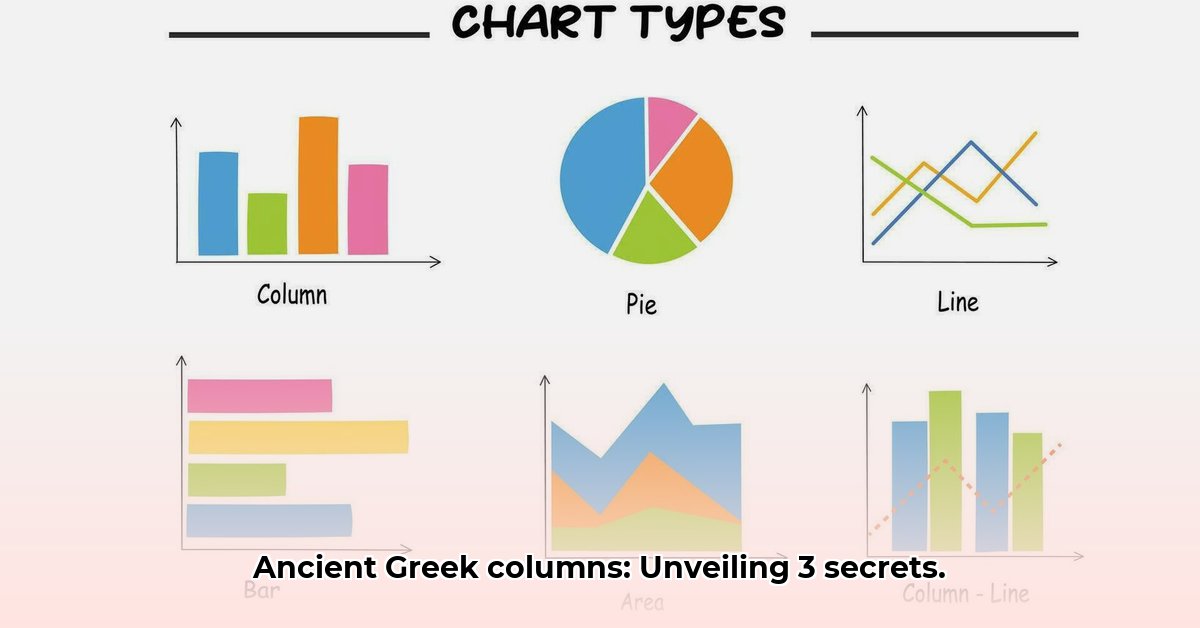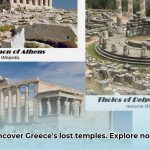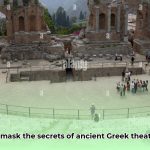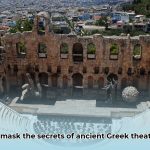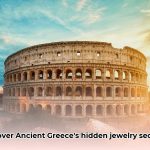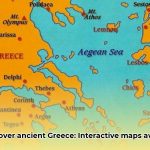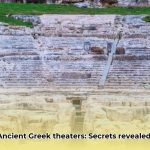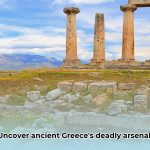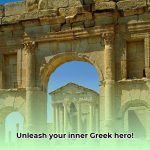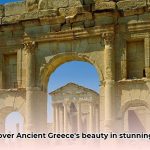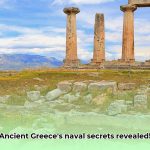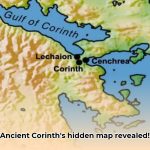Ever been amazed by those impressive columns in pictures of ancient Greece? They weren’t just pretty supports! Each style tells a rich story about the culture that created it. This article explores the Doric, Ionic, and Corinthian column styles. We’ll dive into their unique features, evolution, and lasting architectural impact, revealing centuries of Greek creativity and ingenuity. Learn more about ancient Greek performance spaces by visiting this link on Ancient Greek Theatre.
Exploring Ancient Greek Column Styles and Architectural History
Have you ever wondered what makes ancient Greek buildings so captivating and timeless? A key part of their appeal lies in their magnificent columns. More than just roof supports, these architectural elements made powerful statements about Greek values, aesthetics, and engineering prowess. The Doric, Ionic, and Corinthian styles highlight the evolution of Greek building skills and represent distinct periods in their history.
The Doric Order: Strength in Simplicity & Columnar Foundations
Think of a strong, reliable warrior – that’s the Doric column. Originating in the 7th century BC, it represents simplicity, boldness, and power. These columns are thick and sturdy, slightly tapering upwards to give the illusion of greater height. They lack a base, rising directly from the building’s platform, known as the stylobate. The capital, supporting the roof, is a simple square block (abacus) resting on a rounded cushion (echinus).
The Doric order prioritized strength and practicality, capable of supporting heavy temple roofs. This style emphasizes function over complex decoration, reflecting early Greek values of strength, stability, and practicality. The Parthenon in Athens perfectly exemplifies the Doric style, showcasing its enduring appeal. Imagine it as a dependable, well-worn boot – strong and functional. The Temple of Hephaestus, also in Athens, is another well-preserved example. Did you know the Doric order’s focus on structural integrity and minimalist design influenced later architectural movements like Brutalism?
The Ionic Order: Elegance and Grace & Volute Capital Design
Envision a graceful dancer – that’s the Ionic order. Emerging around the 6th century BC, primarily in Ionia (modern-day Turkey), it emphasizes elegance and sophistication. Ionic columns are taller and slimmer than Doric columns; they include a molded base for a more elevated and refined appearance.
The stand-out feature of the Ionic order is its capital, which showcases elegant volutes (those beautiful, swirling scrolls). These details add movement and fluidity, creating a visually lighter and more graceful impression. Some speculate the scrolls represent stylized ram’s horns, while others believe they are inspired by unfurling scrolls or even women’s hairstyles. The Erechtheion on the Acropolis, with its Porch of the Caryatids (female figure sculptures supporting the roof), beautifully demonstrates the Ionic style’s charm and versatility. Ongoing research explores the symbolic meanings and artistic choices embedded within Ionic designs. Think of this order as a flowing Grecian gown—graceful and sophisticated. The Temple of Athena Nike, also on the Acropolis, is another prime example. The Ionic column’s sophisticated design influenced later architectural styles, particularly during the Renaissance and Neoclassical periods.
The Corinthian Order: Opulence and Detail & Acanthus Leaf Ornamentation
Imagine a lavish royal palace – That’s the Corinthian order. This style, the youngest of the three, appeared around the 5th century BC, originating in Corinth, and emphasizes extravagance and intricate details. Like the Ionic, it includes a base and a slender form. However, the capital is where the magic truly happens.
The Corinthian capital features a riot of ornamentation, overflowing with acanthus leaves and other meticulously crafted carvings. The Temple of Olympian Zeus in Athens exemplifies the Corinthian order’s grandeur and imposing scale. It’s like a jeweled crown—extravagant and magnificent. While the exact origins are still debated, with some attributing the design to the sculptor Callimachus, its impact on architectural aesthetics is undeniable. Historians estimate that the Corinthian order’s popularity grew significantly in the Roman era, becoming a favored choice for monumental structures.
Comparing the Three: A Quick Look at Ancient Greek orders
Here’s a table summarizing the key differences:
| Feature | Doric Order | Ionic Order | Corinthian Order |
|---|---|---|---|
| Shaft | Thick, sturdy, slightly tapered | Slimmer, more slender | Similar to Ionic, often taller |
| Base | None | Present | Present |
| Capital | Simple, square block | Volutes (spiral scrolls) | Acanthus leaves & volutes |
| Overall Style | Simple, strong | Elegant, refined | Ornate, decorative |
| Development | Earliest | Second-oldest | Youngest |
A Legacy That Endures: Ancient Greek Column Inspiration
The influence of ancient Greek column styles remains remarkably strong. The Romans enthusiastically embraced and incorporated them into their buildings, adapting them to suit their own architectural preferences. The Renaissance and Neoclassical periods saw a significant design revival, and modern architects still draw inspiration from these classical forms. These timeless styles remind us of ancient Greece’s extraordinary artistic skill, intellectual curiosity, and engineering capabilities. Their continued popularity speaks to their enduring artistic relevance and their ability to evoke a sense of grandeur, balance, and harmony. Did you know that modern architects still reference the golden ratio and principles of symmetry and proportion when designing columns and other architectural elements?
How Did Ancient Greek Column Construction Techniques Affect Stylistic Variations?
Let’s go back in time and examine how the techniques used to build them shaped their final appearance and aesthetic qualities.
The Doric Order: Strength and Simplicity Construction
Imagine the Parthenon’s imposing presence. Its Doric columns embody strength and simplicity. Often built from marble or limestone, these sturdy pillars lacked bases, connecting directly to the stylobate. Their capitals were simple, designed for function and appearance. The absence of a base and the straightforward capital design reflected the engineering limitations of the early period. This simplicity, born out of necessity, became a defining characteristic of the Doric style. How did the focus on function and structural integrity affect its lasting appeal?
The Ionic Order: Elegance and Refinement Construction
Moving forward, the Ionic order showcased grace and elegance. These columns, taller and slenderer than the Doric, featured a distinct base and a capital with volutes—spiral scrolls. These intricate details required advanced carving techniques and precision. Improved engineering and craftsmanship directly influenced style; the base increased stability, distributing the load more evenly, and the precisely carved volutes demonstrated an increased understanding of engineering and aesthetics.
The Corinthian Order: Ornate Grandeur Construction
The youngest order, the Corinthian, epitomizes ornate grandeur. Columns boast a decorative base, a slender shaft, and a highly embellished capital featuring acanthus leaves. This level of detail demonstrates a mastery of stone carving and a sophisticated understanding of design principles. The complex capitals and intricate designs pushed the limits of available carving techniques, and the Corinthian style’s opulence reflects this newfound freedom and skill.
A Comparative Glance at Construction
| Order | Capital | Base | Shaft | Overall Style |
|---|---|---|---|---|
| Doric | Simple, square | None | Thick, sturdy | Strong, austere |
| Ionic | Volutes (scrolls) | Present | Slender | Elegant, graceful |
| Corinthian | Acanthus leaves | Ornate | Slender | Ornate, majestic |
This table highlights how the evolving ability to create stable, taller columns with increasingly elaborate capitals led to the development of the distinct Greek orders.
Key Takeaways:
- Evolving Greek column orders are inherently linked to advancements in stoneworking and engineering knowledge.
- Each order reflects a distinct balance of structural needs and aesthetic desires, showcasing the ingenuity of Greek architects and builders.
- The transition from Doric to Ionic to Corinthian showcases increasing sophistication in both design and construction techniques.
- The interplay between technical capabilities and artistic expression continues to inspire architects and designers today.
- The Greeks achieved remarkable precision and accuracy in constructing structurally sound and aesthetically pleasing columns, contributing to the enduring legacy of their architectural achievements.
Incorporating Greek Column Elements in Modern Residential Designs
Let’s see how ancient Greek columns continue to shape modern homes, offering a timeless blend of elegance, strength, and sophistication, through the distinct aesthetics of Doric, Ionic, and Corinthian designs.
The Majestic Doric Order in Residential homes now
Imagine a simple, powerful design statement – the Doric order. These sturdy columns, lacking a base and with simple capitals, exude strength, stability, and a sense of timelessness. Think of the Parthenon – its imposing presence speaks volumes. Consider using Doric-inspired columns to frame entrances, support porches, or create striking interior features, such as fireplace surrounds or decorative room dividers. They can range from standalone features to integrating seamlessly into existing structures, adding a touch of classical grandeur to contemporary spaces.
The Elegant Ionic Order in Residential homes Now
The Ionic order introduces a graceful curve with volutes atop the capital, lending itself beautifully to more intimate spaces. The slender columns and delicately decorative capitals create a sense of refinement and balance. Use Ionic-inspired columns to delineate spaces within an open-plan living area, accentuate a staircase for classical elegance, or create a focal point in a garden or patio. They can also frame patios or provide elegant support for balconies, adding a touch of sophistication and charm. With proper engineering, Ionic columns can support significant weight, making them both aesthetically pleasing and structurally sound.
The Ornate Corinthian Order in Residential Homes Now
Finally, we have the most decorative: the Corinthian order. Intricate acanthus leaf capitals are a testament to artistry and craftsmanship, emphasizing lavish detail and visual richness. Use smaller-scale recreations for subtle applications, such as incorporating Corinthian-inspired details in cabinetry, wrought iron features, or a fireplace mantle for carefully considered accents. In larger homes, Corinthian columns can be used to create grand entrances, frame formal dining rooms, or add a touch of opulence to a luxurious master suite.
Comparing the Orders in Modern Design
| Order | Capital | Shaft | Base | Overall Impression |
|---|---|---|---|---|
| Doric | Simple, flat | Robust, tapered | None | Strength, simplicity |
| Ionic | Volutes (scrolls) | Slender, fluted | Present | Elegance, refinement |
| Corinthian | Acanthus leaves | Slender, fluted | Present | Opulence, intricacy |
The Enduring Legacy of Incorporating Greek column
The enduring appeal of Greek design remains undeniable, offering a timeless aesthetic that seamlessly blends with contemporary styles, adding a touch of classical grandeur to any home. The choice of order ultimately depends on the overall design vision and the desired aesthetic effect, but these iconic elements never fail to add grace, sophistication, and a sense of history to any residential space.
Key Takeaways:
- Doric, Ionic, and Corinthian orders offer distinct aesthetic qualities, allowing homeowners and designers to tailor their designs to specific preferences and architectural styles.
- Each order has unique characteristics that make it particularly well-suited for different design contexts, from creating a sense of strength and stability to adding a touch of elegance and opulence.
- Architects and designers often adapt these classical orders using modern materials and scales, creating innovative interpretations that bridge the gap between ancient traditions and contemporary aesthetics.
- Careful consideration of proportion, scale, and context is essential when incorporating Greek column elements into modern residential designs to ensure a harmonious and visually appealing result.
Influence of Greek Column Orders on Renaissance Architecture in Italy
Let’s explore how Doric, Ionic, and Corinthian orders, each with its unique personality, profoundly influenced the aesthetics and design principles of Renaissance architecture in Italy, leaving an enduring legacy that continues to shape architectural styles today.
The Sturdy Doric Order on Renaissance Architecture
Rugged simplicity defines the Doric order. Thick, powerfully fluted columns stand proud and unadorned. Their simple capitals lend an air of understated elegance. Rising directly from the stylobate on which the temple rests, the influence is apparent in its simple elegance and structural integrity. Renaissance architects, seeking to recapture the grandeur of classical antiquity, embraced the Doric order’s simplicity and strength, incorporating it into the facades of palaces, churches, and public buildings.
The Elegant Ionic Order on Renaissance Architecture
The Ionic order introduces refinement and grace, with slender columns topped with volutes that create a sense of movement and visual interest. A molded base supports the column, adding to its overall elegance and sophistication. The influence on later architectural styles cannot be overstated. The Ionic order was a breath of fresh air. Renaissance architects were drawn to the Ionic order’s harmonious proportions and delicate details, using it to create a sense of balance and refinement in their designs.
The Ornate Corinthian Order on Renaissance Architecture
The Corinthian order is all about ornamentation and extravagance. Slender columns have capitals adorned with dramatically carved acanthus leaves, creating a sense of detail and luxury. The order adds complexity and visual richness to architecture. The influence is powerfully reflected through decorative motifs and overall aesthetics. Renaissance architects embraced the Corinthian order’s opulence and used it to create a sense of grandeur and splendor in their most important buildings.
Comparing the Orders for Renaissance
| Order | Shaft | Capital | Base | Overall Feel |
|---|---|---|---|---|
| Doric | Thick, sturdy | Simple | Absent | Powerful, bold |
| Ionic | Slender | Volutes | Present | Elegant, refined |
| Corinthian | Slender | Acanthus leaves | Present | Ornate, luxurious |
These orders are not merely aesthetic choices but reflect societal values and cultural ideals. The sturdy Doric speaks to practicality and strength, while Ionic and Corinthian reveal a growing appreciation for detail, refinement, and luxury.
A Lasting Legacy of Greek Design.
Their influence extended far beyond Greece. Roman architects embraced these styles, greatly impacting the Renaissance in Italy. Italian architects drew inspiration, blending classical forms with innovative ideas, resulting in stunning buildings that celebrated the beauty and harmony of classical architecture. Classical ideals fuelled a creative explosion and shaped aesthetics throughout Europe, establishing a new standard of architectural excellence.
Key Takeaways:
- Doric, Ionic, and Corinthian orders represent a progression of architectural advancement, reflecting evolving aesthetic preferences and construction techniques.
- Each order possesses unique features, evoking distinct meanings and contributing to the overall character and atmosphere of the buildings in which they are used.
- Their impact on the Renaissance was profound, shaping the aesthetics of some of the most iconic buildings in Italy and influencing architectural styles throughout Europe.
- Understanding these classical orders provides valuable insight into the evolution of Western architecture and the enduring influence of ancient Greek design principles.
- The timeless beauty and enduring relevance of these orders highlight the power of simplicity, balance, and harmony in architectural design.
- Discover Ancient Greece Weapons: A Comprehensive Guide to Military Technology - August 8, 2025
- Discover Ancient Greek Swords: A Comprehensive Guide - August 8, 2025
- Explore Ancient Athens: Unveiling the City’s Secrets Through Maps - August 8, 2025
